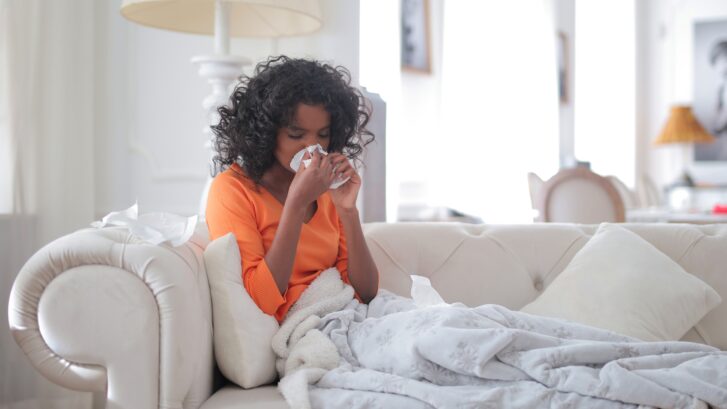Prepare Now for Fall Allergies
We love the sunny, warm weather here in southern Florida, but unfortunately it’s also a recipe for an extended allergy season. We not only get a longer time to encounter summer pollens, including flowers and grasses, soon we’ll be having to deal with the fall-blooming ragweed as well as mold allergies that arise from our state’s hot, humid weather.
Add to that the problem of having to endure the symptoms of fall allergies while wearing masks, and this year could prove even more troublesome for allergy sufferers. So our concierge doctors want you to try to get ahead of the curve and begin preparing now to keep your fall allergies under control as much as possible.
How pollen triggers allergies
Pollen is the yellow powdery microspore produced by the male part of a flower (anther) used to fertilize the female part (stigma). It travels by means of wind, insects, or birds.
Pollen is one of the most common allergens in the United States, affecting some 25 million people. Because the grains are so fine, they travel easily and are readily inhaled. Then the body’s immune system mounts a defense against what it interprets as a harmful invader, producing an outpouring of histamine to counteract the trigger. The result, known as hay fever or allergic rhinitis, produces a wave of uncomfortable symptoms:
- sneezing
- runny nose
- itchy, watery eyes
- cough
- nasal congestion
- sinus pressure, leading to facial pain
- scratchy throat
- decreased sense of taste or smell
Symptoms are not serious unless they trigger an asthma attack in those with the disease, but note that several of these—including a cough and a decreased sense of taste or smell—are also symptoms of infection with COVID-19. This is all the more reason to keep your allergies under control, so you can tell the difference.
Types of allergies
There are many types of pollen, including those from trees, grasses, weeds, including ragweed, and flowers, and different people react differently to each of them. That’s why the pollen counts announced on weather reports, while helpful in a general sense, don’t necessarily reflect your body’s immune reactions. It all depends on your particular allergy.
Mold can also trigger allergies in sensitive individuals. As mentioned above, Florida has more than our share of unwanted mold, thanks to our high humidity and warm temperatures. These conditions become even more pronounced following tropical storms and hurricanes, and unfortunately they create the ideal breeding ground for mold.
In those who are allergic to mycotoxins (the toxic compounds produced by mold), the symptoms are largely confined to respiratory issues, including wheezing, red or itchy eyes, or sniffling and sneezing. Those with chronic respiratory illnesses such as chronic obstructive pulmonary disorder (COPD) or asthma may have difficulty breathing in homes with mold, and some mold can trigger asthma attacks.
Treatments
Because COVID-19 is known to attack the lungs, anything you can do to safeguard them against extra stresses like fall allergies will help if you should contract the coronavirus.
Depending on the severity of your symptoms, there are several ways to treat allergies.
Over-the-counter (OTC) remedies include:
- nasal sprays
- oral antihistamines
- decongestants
- combination oral antihistamines and decongestants
- nasal irrigation, with an OTC saline spray or a neti pot
Medical treatments include:
- medications to block allergic reactions
- medications to ease symptoms
- tests to determine which pollen triggers the allergy
- immunotherapy (allergy shots) to overcome the allergy
How to avoid allergens
Of course, the best treatment is to avoid exposing yourself to pollens and mold as much as possible. If you have allergies:
- Stay indoors on dry, windy days.
- Avoid outdoor activity in the early morning when pollen counts are highest.
- Change clothing and shower after spending time outdoors.
- Keep windows closed, in the home and car.
- Don’t line-dry clothing or bedding.
- Wear a pollen mask if you need to work outdoors.
- Use a vacuum equipped with a HEPA filter.
- Use a portable air cleaner with a HEPA filter in your bedroom.
To keep mold under control, the Centers for Disease Control and Prevention (CDC) recommends that you keep humidity levels in the home no higher than 50 percent all day long, using an air conditioner and/or a dehumidifier to achieve this level. And make sure to use exhaust fans in the kitchen and bathroom.
On hard surfaces, mold can be removed with commercial products, soap and water, or a bleach solution of no more than one cup of bleach in a gallon of water, the CDC says. Be sure to thoroughly clean and dry the area because sensitive individuals can still have a reaction to the dead mold. In addition, mold contamination can recur if a source of moisture remains. Finally, if you know you’re allergic to a particular type of allergen, or that you begin having symptoms at this time of year, start taking your allergy medication before symptoms begin. And if you need extra help getting your symptoms under control, be sure to let us know.

